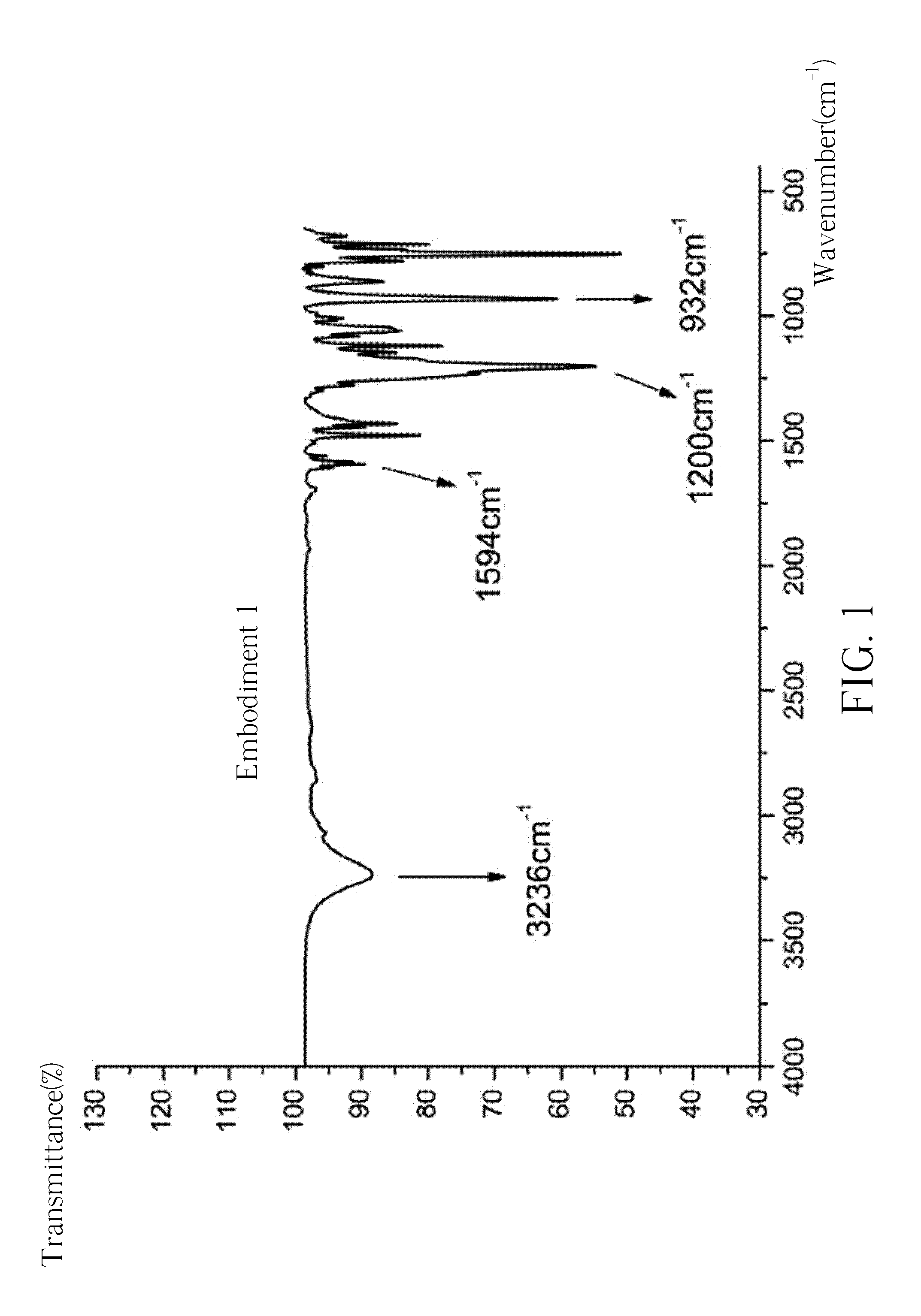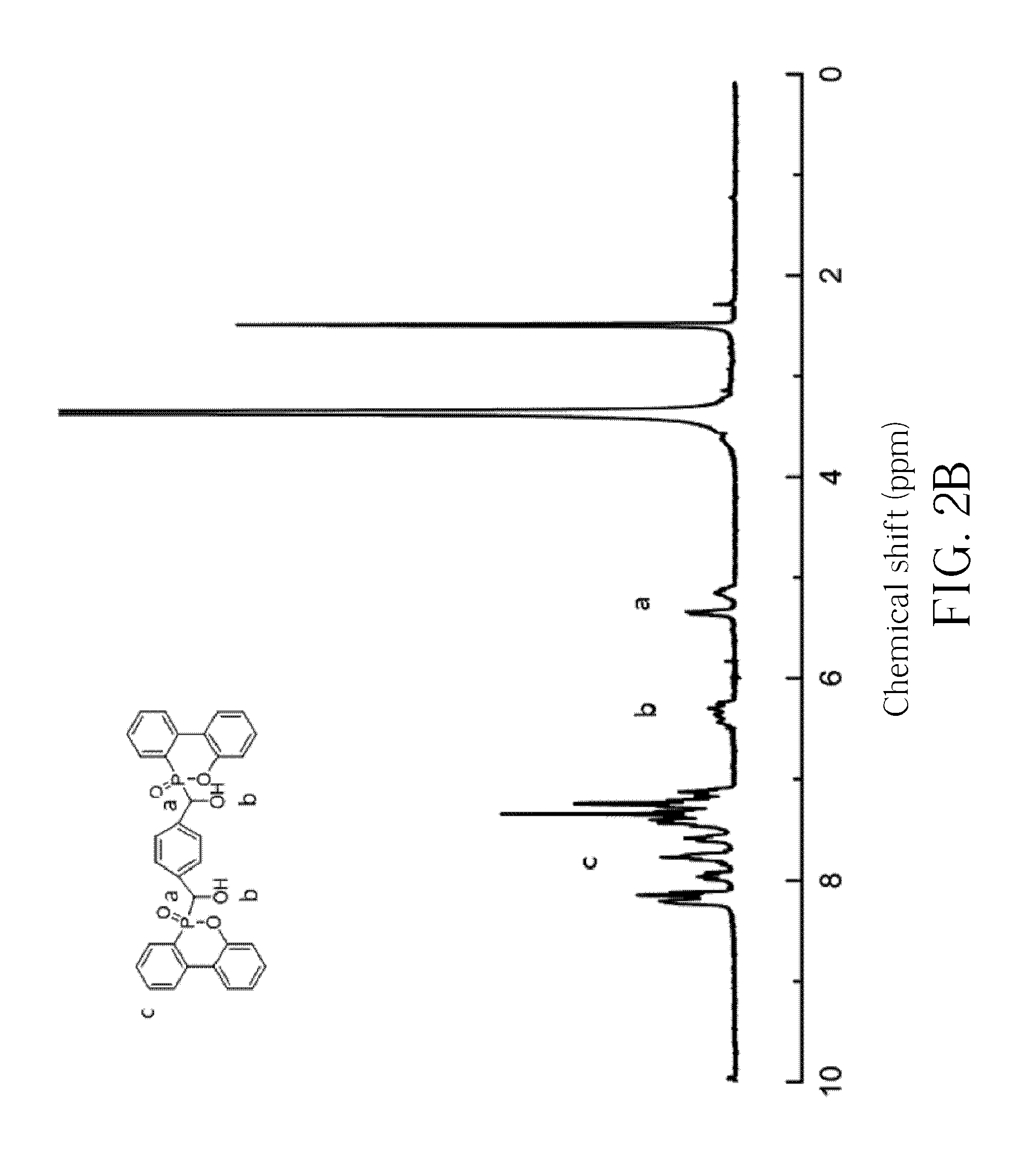Phosphaphenanthrene-based compound and related preparation method and application
a technology of phosphaphenanthrene and compound, which is applied in the field of preparation of phosphaphenanthrene-based compound, can solve the problems of warping and deformation of laminates, reducing the flatness of laminates, and reducing the thermal expansion coefficient of laminates made from resin compositions. , the effect of symmetrical structure and less polarity of functional groups
- Summary
- Abstract
- Description
- Claims
- Application Information
AI Technical Summary
Benefits of technology
Problems solved by technology
Method used
Image
Examples
embodiment 1
Preparation of Phosphaphenanthrene-Based Compound
[0093]500 ml of toluene, 0.4 mol (approximately 78.64 g) of DOPO and 0.2 mol of 1,4-phthalaldehyde (about 26.82 g) are placed in a 1000 ml the three-necked flask equipped with a thermometer and a condenser and are heated and stirred for 5 hours under a reflux environment. The solution is cooled to room temperature, filtered off and dried under vacuum, then a white powder is obtained. The yield is 87.6%.
[0094]The obtained white powder is analyzed by the reflection-type Fourier transform infrared spectroscopy (FTIR), and the result is shown in FIG. 1. The FTIR spectrum reveals peaks indicative of a CH—OH at 3236 cm−1, a P-Ph at 1594 cm−1, a P═O at 1200 cm−1 and a PO-Ph at 932 cm−1. The obtained white powder is further analyzed by the hydrogen nuclear magnetic resonance spectroscopy (1H-NMR, 300 MHz, DMSO), and the result is shown in FIG. 2A and FIG. 2B. The 1H-NMR spectrum reveals peaks indicative of a —CH-Ph at δ=5.1-5.5 ppm (i.e., the...
embodiment 2
Preparation of Phosphaphenanthrene-Based Compound
[0097]500 ml of toluene, 0.4 mol (approximately 78.64 grams) of DOPO and 0.2 mol of 1,4-phthalaldehyde (about 26.82 g) are placed in a 1000 ml three-necked flask equipped with a thermometer and a condenser and are heated and stirred for 5 hours under a reflux environment. The solution is cooled to room temperature, filtered off and dried under vacuum, and then a white powder is obtained. The yield is 91.5%. From the analysis results of the FTIR and 1H-NMR, it is convinced that the white powder has a structure expressed by formula (VIII) above.
[0098]Then, add 0.5 mol of the white powder and 1.5 mol of sodium hydroxide to a four-necked flask with 1 liter of toluene. Next, heat the solution up to 70° C. and stir it for 30 minutes. Subsequently, add 1.5 mol of 4-chloro-methyl styrene and 0.1 mol of tetrabutylammonium bromide to the solution. Stir for 10 hours. After the reaction is completed and the solution is cooled to room temperature,...
embodiment 3
Preparation of Resin Composition Containing Phosphaphenanthrene-Based Compound
[0112]According to the ratio listed in Table 4, the phosphaphenanthrene-based compound prepared in the embodiment 1 (as shown in formula (VIII)) and the phosphaphenanthrene-based compound prepared in the embodiment 2 (as shown in formula (XVI)) are respectively adequately mixed with polyphenylene ether resin, cyanate ester resin, maleimide, flame retardants, inorganic fillers, curing accelerator and solvent to form resin compositions having the phosphaphenanthrene-based compound, i.e., example 1 to example 12 (hereinafter denoted as E1 to E12).
[0113]Comparison 3: Preparation of Resin Composition
[0114]According to the ratio listed in Table 5, the phosphaphenanthrene-based compound prepared in the embodiment 1 (as shown in formula (VIII)) and the phosphaphenanthrene-based compound prepared in the embodiment 2 (as shown in formula (XVI)) are selectively mixed with polyphenylene ether resin, cyanate ester resi...
PUM
| Property | Measurement | Unit |
|---|---|---|
| dissipation factor | aaaaa | aaaaa |
| dissipation factor | aaaaa | aaaaa |
| melting point | aaaaa | aaaaa |
Abstract
Description
Claims
Application Information
 Login to View More
Login to View More - R&D
- Intellectual Property
- Life Sciences
- Materials
- Tech Scout
- Unparalleled Data Quality
- Higher Quality Content
- 60% Fewer Hallucinations
Browse by: Latest US Patents, China's latest patents, Technical Efficacy Thesaurus, Application Domain, Technology Topic, Popular Technical Reports.
© 2025 PatSnap. All rights reserved.Legal|Privacy policy|Modern Slavery Act Transparency Statement|Sitemap|About US| Contact US: help@patsnap.com



